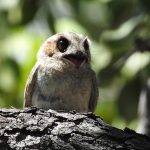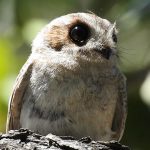AUSTRALIAN OWLET-NIGHTJAR
The Australian Owlet-Nightjar is a small and cryptic bird. They belong to the family Aegothelidae, which is related to the frogmouths. While they share similarities with owls, they are not closely related to them. Their range is restricted to Australia, and they can be found in various habitats, including woodlands, forests, and heathlands. They are most commonly seen in the eastern and southern parts of the country.
Primarily nocturnal they are well adapted to low light conditions and use their large eyes to hunt for insects and other small prey in the darkness. They have a distinctive appearance, with a large head, large eyes, and a relatively small, stocky body. Their plumage is brownish-grey, providing excellent camouflage in their woodland habitats.
Owlet-Nightjars have soft feathers that help muffle the sound of their flight. This adaptation allows them to fly almost silently, making it easier for them to catch prey without being detected. These birds primarily feed on insects and other small invertebrates. They are skilled aerial hunters, capturing prey in flight or from perches.
While they are generally quiet birds, Owlet-Nightjars can produce a variety of calls, including soft whistles and chattering sounds. They are more vocal during the breeding season when they use calls to communicate with potential mates and establish territories.
Owlet-Nightjars often nest in tree hollows or crevices in rocks. They lay one or two eggs, and both parents share the responsibility of incubating the eggs and caring for the young.
Owlet-Nightjars are known for their elusive behavior and are often difficult to observe in the wild due to their nocturnal habits and excellent camouflage. They can be best observed during their crepuscular activity periods at dawn and dusk.



